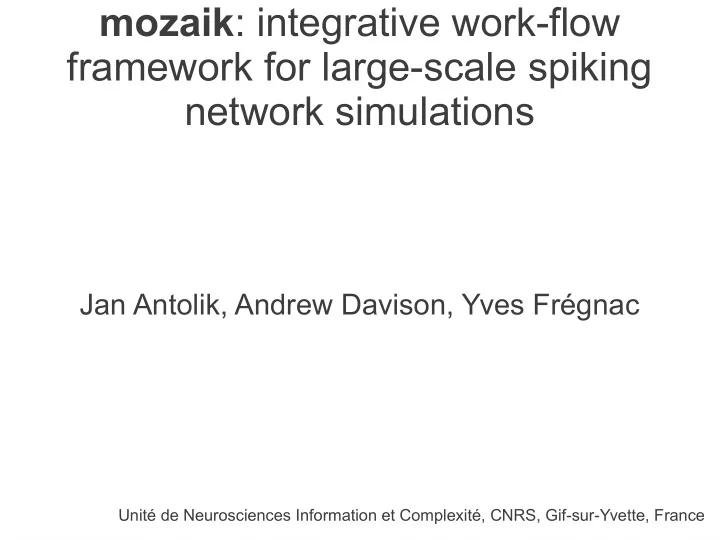

mozaik : integrative work-flow framework for large-scale spiking network simulations Jan Antolik, Andrew Davison, Yves Frégnac Unité de Neurosciences Information et Complexité, CNRS, Gif-sur-Yvette, France
Motivation ● Most current spiking network simulations: ● Small to medium scale ● Simple homogeneous architectures ● Focus on statistical rather then functional properties ● Simple experimental and stimulation protocols ● Recent shift to: ● Large-scale ● Heterogeneous architectures reflecting anatomy ● Investigation of functional properties ● Involved experimental and stimulation protocols reflecting biological experiments
Typical work-flow cycle
Motivation ● Number of tools doing parts of the work-flow (nest, neuron, pyNN, neo, NeuroTools, ...) ● Some areas not covered ● No unifying framework connecting all these tools into single work-flow
mozaik ● Python set of modules offering high-level integration of the work-flow ● Integrates ● Model design ● Experimental protocol design ● Stimulus handling ● Data storage and high-level manipulation ● Analysis ● Plotting
mozaik design ● Built on top of existing tools ● simulator ↔ pyNN (NEST*) ● storage ↔ neo ● stimuli ↔ topographica * ● analysis ↔ neurotools * ● plotting ↔ matplotlib ● For now focused on cortex and visual modality ● Written in modular way ● All pure python
Model design ● Fully parametrized via neurotools ParameterSet ● Model is composed of ● 2D sheets of neurons (layers) – various distributions of neurons in space – handles cortical magnification ● Projections between sheets – supports all the basic types in pyNN – adds gabor receptive fields – push-pull connectivity – afferent input parametrized with maps
Model design ● Sensory input sheet – currently retina supported – handling of visual space ● Model handles retrieval of data from simulator (via pyNN) ● Components add annotations to datastore such as neural positions, initialized orientation preferences etc.
Stimuli ● System for identifying stimuli and their parameters ● Used through the mozaik to track the origin of any recordings ● Currently very simple high level abstract API ● Makes it trivial to re-use stimuli from topographica. ●
Experiment control ● Currently very simple principle ● Lot of placeholders for potentially more involved logic ● User defines order of experiments ● Each experiment ● Defines a stream of stimuli ● Any analysis to be performed on the recorded data ● The experimental controller: ● Goes experiment by experiment ● Presents the list of stimuli to the model ● Shows blank stimuli for x time between each stimuli ● Executes analysis ● Stores both recording and analysis results into datastore
Storage ● Storage module aggregates all the info ● Recordings (spikes, vm, conductances) ● Neuron positions ● Stimuli ● Additional data annotations ● Stores them in neo format ● pickled format ● hdf5 (not tested) ● Allows for doing views into the datastore
Queries ● Queries allow filtering data in datastore ● (datastore/datastore view) → datastore view ● This allows for powerful customization of analysis and plotting tools ● Available query examples: ● constrain data to single sheet ● constrain data to certain type of stimuli ● splice data based on stimulus parameter value ● Contains both function level and ParameterSet interface
Analysis ● Trivial high level interface: ● Input is datastore view ● Each analysis should know how to filter out the most general data it is applicable to (using queries) ● As a results it creates AnalysisDataStructure and returns it ● This gets stored back into Datastore ● This way analysis should be highly customizable just by pre-filtering the data it is passed
Plotting ● Built on top of matplotib ● Similar philosophy as analysis ● Input is a datastore/view ● Given plotting algorithm filters out the most general set of data it can handle and plots it ● Parametrized via ParameterSet ● High-level plotting API that allows for hierarchical definition of figures ● Uses the prior knowledge of the mozaik primitives to automatize lot of plotting code
Limitations ● Very early pre-alpha stage ● Non-interactive ● Currently all data in memory ● Only visual cortex scope ● Documentation ● No tests
Future work ● Random data access on the hard-drive ● Higher-level model components (cortical layers, cortical areas, higher-level connectors) ● Project tracking (Sumatra) ● Automatic checking of experiment order sanity ● Support of FACETS like benchmarks within the Experimental control framework ● GUI for browsing and plotting of data in datastore ● You tell me!!!
https://github.com/antolikjan/mozaik
Recommend
More recommend